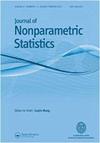各向同性协方差函数的非参数估计
IF 0.9
4区 数学
Q3 STATISTICS & PROBABILITY
引用次数: 0
摘要
利用Bernstein多项式序列构造了一个非参数模型来逼近任意有效的各向同性协方差函数,并利用常用范数和范数研究了相关的逼近性质。然后,提出了一种计算效率高的筛极大似然(sML)估计方法,用于非参数估计中有效的未知各向同性协方差函数。在递增域下,证明了所提筛ML估计的一致性。将该方法与现有的几种非参数方法以及常用的参数方法进行了数值比较。基于模拟数据的数值结果表明,我们的方法在减少由于模型错误规范引起的偏差方面优于参数方法,并且在期望值和规范值显着降低方面优于非参数方法。并举例说明了在降水数据中的应用,以展示一个实际案例研究。还提供了额外的技术细节和数字插图。本文章由计算机程序翻译,如有差异,请以英文原文为准。
Nonparametric estimation of isotropic covariance function
A nonparametric model using a sequence of Bernstein polynomials is constructed to approximate arbitrary isotropic covariance functions valid in and related approximation properties are investigated using the popular norm and norms. A computationally efficient sieve maximum likelihood (sML) estimation is then developed to nonparametrically estimate the unknown isotropic covariance function valid in . Consistency of the proposed sieve ML estimator is established under increasing domain regime. The proposed methodology is compared numerically with couple of existing nonparametric as well as with commonly used parametric methods. Numerical results based on simulated data show that our approach outperforms the parametric methods in reducing bias due to model misspecification and also the nonparametric methods in terms of having significantly lower values of expected and norms. Application to precipitation data is illustrated to showcase a real case study. Additional technical details and numerical illustrations are also made available.
求助全文
通过发布文献求助,成功后即可免费获取论文全文。
去求助
来源期刊

Journal of Nonparametric Statistics
数学-统计学与概率论
CiteScore
1.50
自引率
8.30%
发文量
42
审稿时长
6-12 weeks
期刊介绍:
Journal of Nonparametric Statistics provides a medium for the publication of research and survey work in nonparametric statistics and related areas. The scope includes, but is not limited to the following topics:
Nonparametric modeling,
Nonparametric function estimation,
Rank and other robust and distribution-free procedures,
Resampling methods,
Lack-of-fit testing,
Multivariate analysis,
Inference with high-dimensional data,
Dimension reduction and variable selection,
Methods for errors in variables, missing, censored, and other incomplete data structures,
Inference of stochastic processes,
Sample surveys,
Time series analysis,
Longitudinal and functional data analysis,
Nonparametric Bayes methods and decision procedures,
Semiparametric models and procedures,
Statistical methods for imaging and tomography,
Statistical inverse problems,
Financial statistics and econometrics,
Bioinformatics and comparative genomics,
Statistical algorithms and machine learning.
Both the theory and applications of nonparametric statistics are covered in the journal. Research applying nonparametric methods to medicine, engineering, technology, science and humanities is welcomed, provided the novelty and quality level are of the highest order.
Authors are encouraged to submit supplementary technical arguments, computer code, data analysed in the paper or any additional information for online publication along with the published paper.
 求助内容:
求助内容: 应助结果提醒方式:
应助结果提醒方式:


